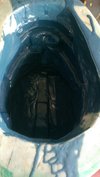My thought for the internal structure would be to construct it from fiberglass/bondo during the hardening/reinforcing stage. I figure that would give it the most stability and security as opposed to tacking something onto the finished piece.
Now, to see if I understand your suggested process correctly, the first and second molds would be combined to create an "inner shell" that would then be slid into the newly cast helmet (third mold)?
I'll run my thoughts by you and see if you, an obviously more experienced caster, think it's a viable method.Now, being that I am not an experienced molder/caster, I have no clue regarding the proper lingo or terminology, so hopefully I can get the concept from my imagination to yours without too much being lost in transition.
I'm thinking essentially a 5-piece mold kit. The video here showed a 3-piece mold kit, consisting of the soft main mold, and two halves that formed the hard outer shell that keeps the main mold from warping. What I'm thinking is, using the video as a reference point, once those three parts are set, complete with a matching flange on the hard shell halves, remove the clay build-up and replace it with a "washer" of sorts, essentially a ring with a few straws/tubes fed through it that will become the pour and vent holes. Could be nothing more than cardboard with the straws attached with glue/putty and coated with some saran/plastic wrap just so the molding gel (as well as the release agent) doesn't soak into it. The basic function of this piece is to provide the aforementioned holes and to create enough of a gap between the inner and outer gel molds that the clay build up (intended to extend the mold enough that the "rough edges" of the cast will be beyond the intended mold area) won't be rendered useless. With the first 3 pieces of the mold (from the video) and this washer in place, the entire inside (including the washer) would be sprayed with release agent, then the first of the two internal mold pieces would be made with the gel, being sure to get it fully into any groove, indentation, and around every stud and/or support strut, and build it all the way up to the top of the washer, which should sit evenly with the flange from the external mold. Straws should stick up a bit higher than that. The idea is to build this part of the mold up enough so that the inside of it it as smooth as possible. Once it sets, the fifth and final piece would be a plaster "plug" starting from the basin created by the inner gel mold, and build it all the way up and out to the edge of the flange, working around the straws to retain the air holes. Maybe a ring of saran wrap/tin foil should be made first to cover over the exterior gel and plaster so that the internal and external molds don't fuse together. Anyway, once the internal plaster mold/plug if set, pull it out, remove the internal gel mold, take off the external plaster halves and the external gel mold to get the washer and the part to be cast out. Honestly I'm not sure whether it's better to make sure the straws can be removed, or to just trim them enough that they won't disrupt the "buffer" created by the clay build up. At least one straw should be pulled out and the hole made large enough to pour through.
To make a cast, assemble the first three pieces as you normally would. Then insert the plaster "plug" piece into the cavity of the internal gel mold. The purpose of the plug is to keep the internal mold from collapsing/shifting during the casting process, and to make sure the internal mold is properly aligned. Once the internal mold assembly is together it can be bolted/clamped to the flange of the external mold to seal it (if the external gel mold extends out as much as the plaster, that will provide a perfect built-in gasket to seal it tight). The casting material can then be poured through the holes (tapping the mold frequently to help release any trapped air) until it's sufficiently filled (I'd assume between the pour and vent holes it would be fairly easy to see when the mold is sufficiently filled). Once the cast is set, unbolt/unclamp the flanges, pull the plug out, peel the internal gel mold out, remove the external hard shell, and peel off the external gel mold.
In addition to being able to reproduce internal structures, I would imagine that this method would also eliminate a lot of the "guesswork" or slush casting as well as the tedium of rotational casting, as far as getting a uniform thickness throughout the entire piece, as once it's filled, the mold is essentially complete.
Although thinking on it now, I can see one potential complication. With the majority of the casting material trapped between the two molds and the only air coming in from the vent holes, curing time could be rather lengthy. And I don't know what the probability would be for air bubbles to form inside the mold after the cast is poured. If there is a good chance of that, frequent tapping might still be necessary. Without having any experience I can't even hazard a guess to how big or even how likely a problem either of those might be. What are your thoughts on it? And if any clarification is needed on the concept and/or process (I know I'm not always the best at taking what's in my head and turning it into coherent speech) just let me know and I'll try to clear it up.
I'll attach a rough diagram I threw together in MS Paint just to give an idea of how it would all look together.








